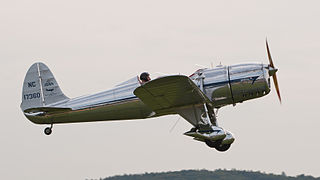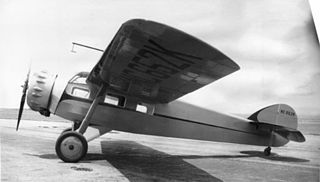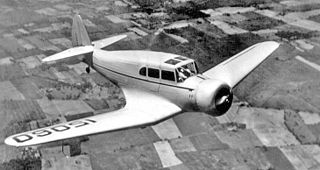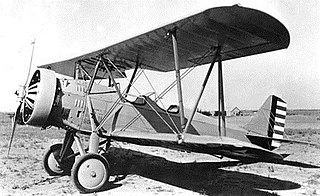
The Fairchild PT-19 is an American Fairchild Aircraft monoplane primary trainer aircraft that served with the United States Army Air Forces, RAF and RCAF during World War II. It was a contemporary of the Kaydet biplane trainer and was used by the USAAF during Primary Flying Training. As with other USAAF trainers of the period, the PT-19 had multiple designation(s) based on the powerplant installed.

The Northrop C-19 Alpha was a series of three aircraft purchased from Northrop by the US Army Air Corps in 1931. They were slightly modified versions of the civil Northrop Alpha Type 2.

The Ryan STs were a series of two seat, low-wing monoplane aircraft built in the United States by the Ryan Aeronautical Company. They were used as sport aircraft, as well as trainers by flying schools and the militaries of several countries.

The Curtiss XA-14 was a 1930s United States airplane, the first multi-engine attack aircraft tested by the United States Army Air Corps. Carrying a crew of two, it was as fast as the standard pursuit aircraft in service at the time.

The Curtiss A-18Model 76A Shrike II was a 1930s United States twin-engine ground-attack aircraft. It was the production test version of that company's A-14 Shrike.

The Consolidated PT-1 Trusty was a biplane primary trainer used by the United States Army Air Service (USAAS).

The Consolidated Model 2 was a training airplane used by the United States Army Air Corps, under the designation PT-3 and the United States Navy under the designation NY-1.

The Waco Aircraft Company (WACO) was an aircraft manufacturer located in Troy, Ohio, United States. Between 1920 and 1947, the company produced a wide range of civilian biplanes.

The Wright R-760 Whirlwind was a series of seven-cylinder air-cooled radial aircraft engines built by the Wright Aeronautical division of Curtiss-Wright. These engines had a displacement of 756 in³ (12.4 L) and power ratings of 225-350 hp (168-261 kW).

The Cessna Model DC-6 was a 1920s American high-wing four-seat tourer built by the Cessna Aircraft Company. It was used by the United States Army Air Corps as the UC-77/UC-77A.

The Consolidated Model 2 was a PT-1 biplane trainer diverted to the United States Navy for a trainer competition in 1925. It beat out 14 other designs, and was ordered into production as the NY-1.

The Consolidated Model 21 was an American two-seat training aircraft built by the Consolidated Aircraft Company. It was used by the United States Army Air Corps with the designation PT-11 and the United States Coast Guard under the designation N4Y.

The Curtiss Model 55 Kingbird was an airliner built in small numbers in the United States in the early 1930s. It was a twin-engine aircraft with a fuselage derived from the single-engine Curtiss Thrush. The Kingbird had two engine nacelles mounted on the struts on either side of the fuselage that braced the wing and the outrigger undercarriage. A distinctive design feature was the aircraft's blunt nose, located behind the propeller arcs. This allowed the engines to be mounted closer to each other and to the aircraft's centerline, therefore minimising asymmetrical thrust in case of an engine failure. For the same reason, the Thrush's single tailfin was replaced by twin tails on the Kingbird, and the main production model, the D-2 fitted a second horizontal stabilizer and elevator between these fins.

The Fairchild Model 45 was a 1930s American five-seat cabin monoplane aircraft designed and built by Fairchild.

The Fokker F-14 was an American seven/nine passenger transport aircraft designed by Fokker and built by their Atlantic Aircraft factory in New Jersey.
The Fletcher FBT-2 was a military trainer aircraft built in the United States in the early 1940s. Although it was never entered production as a trainer, it was ordered in small numbers as a target drone but when that was cancelled played a small part in the development of guided bombs.

The Stearman Model 6 Cloudboy was a 1930s American training biplane designed and built by the Stearman Aircraft Company of Wichita, Kansas.

The Mohawk M1C was a 1920s American two or three-seat low-wing monoplane designed and built by Mohawk Aero Corporation of Minneapolis, Minnesota. One M1C was evaluated by the United States Army Air Corps in 1930 as the YPT-7 Pinto for use as a primary trainer.

The Thaden T-4 Argonaut was a 1930s American four-seat all-metal cabin monoplane built by the Thaden Metal Aircraft Company of San Francisco, California.

The Curtiss CA-1 was an American five-seat biplane amphibian designed by Frank Courtney and built by Curtiss-Wright at St Louis, Missouri.



















